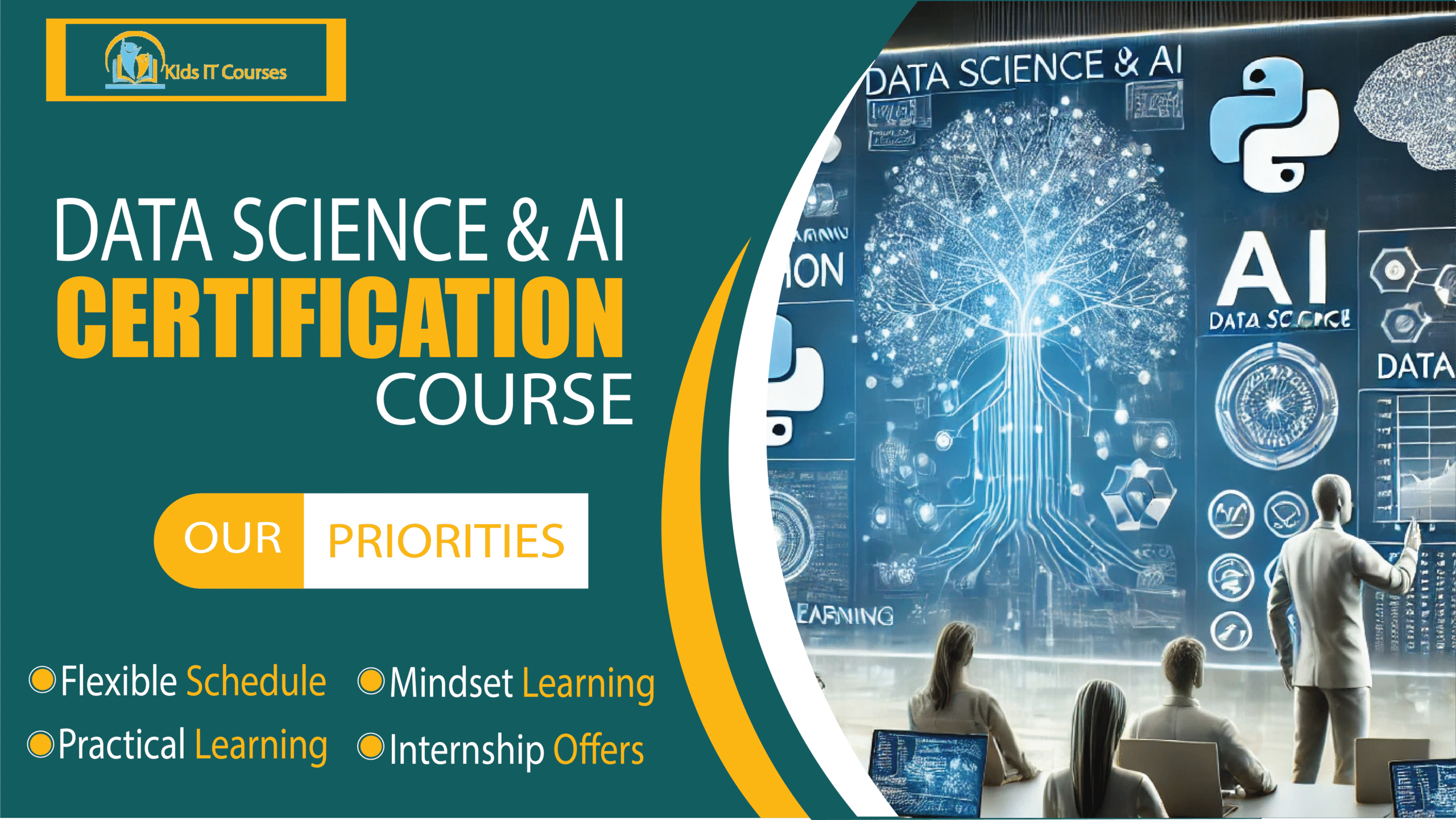
Data Science and AI Course for Kids
Definition
- It means learning how to understand and use information. Kids find patterns in numbers, words, or pictures.
- AI means making computers think and learn like humans. It helps machines answer questions or play games smartly.
- Kids work with fun data like animals, games, or weather. This makes learning exciting and easy to understand.
They use beginner-friendly tools to try coding and projects. No hard math—just fun experiments!
Kids learn how to use data and AI to solve problems. Like guessing what toy someone likes or sorting pictures.
- They build games, chatbots, or simple AI art. It mixes learning with creativity and play.
Importance
- Children learn how things like voice assistants and smart apps work. It makes them smarter about the tech they use every day.
- They solve puzzles using data and think step by step. This sharpens their brain and boosts creativity too!
Kids learn to collect, read, and make sense of numbers and facts. It helps them make better decisions in fun ways.
They use simple coding tools to make smart programs. It’s a fun way to start learning real tech skills.
- Many projects are done in groups, helping kids share ideas. They learn to work together and explain their thoughts.
Advantages for Data Science & AI
- Kids learn how to think clearly and solve problems using facts. It helps them become better decision-makers.
- They explore cool tools like chatbots and smart games. It shows how computers can learn like people.
- They learn to look at numbers, charts, and patterns. This builds strong math and logic skills.
- Kids create simple projects like quizzes or games. It keeps learning playful and exciting.
They see how AI is used in phones, cars, and even sports. It shows them how tech is part of everyday life.
Why Learn Data Science & AI?
There are several reasons to start freelancing: Done on the side around your job, it’s a way to generate extra income to pay off debt or save for a rainy day. It’s affordable to start if you already have the skills and equipment to do the job. You can start quickly.
For Furthermore detail you can see the outline.
We learn Data Science and AI because they help us understand how to collect, analyze, and use data to make smart decisions, and because they power the technology behind things like voice assistants, recommendation systems, and self-driving cars. By learning these subjects, we gain the skills to solve real-world problems, build intelligent machines, and prepare for a future where AI will play a major role in every field. We learn Data Science and AI to understand how data can be collected, analyzed, and used to make smart decisions, which helps us solve real-world problems more efficiently. By learning AI, we gain the ability to build intelligent systems like chatbots, recommendation engines, or self-driving features, making us future-ready for careers in technology. Data Science and AI are shaping every field, from healthcare to entertainment, making it important to learn them from a young age. They teach us how to turn data into useful insights. This empowers us to become creators, not just users, of future technologies. We learn Data Science and AI to help kids understand how smart technology works around them. It teaches them to solve problems, think logically, and use data to make decisions. They also get to be creative by building fun projects like games or chatbots. Most importantly, it prepares them for a tech-filled future in a fun and simple way.
Session 1 : What is Data Science & AI?
What is data? What is intelligence in machines?
Real-world AI: voice assistants, chatbots, game bots
How data helps AI learn
Fun activity: AI vs human guessing game
Session 2 : Data Collection & Organization
Create tables of favorite games, foods, or animals
Organize data into rows and columns
Use spreadsheets or Google Sheets
Activity: Conduct a class/family survey
Session 3 : Exploring Data – Patterns & Predictions
- What is a pattern?
- Sort and filter data to find trends
- Use pie charts, bar graphs
- Activity: Make predictions based on simple data (e.g., Which fruit is most loved?)
Session 4 : Visualizing Data Like a Pro
- Graphs, infographics, dashboards
Tools: Canva, Google Sheets, or Scratch extensions
Project: Visualize your own survey results
Session 5 : How Machines Learn – Intro to Machine Learning
Supervised vs unsupervised learning
Learn with images, numbers, or words
Train a model to sort cats vs dogs using online tools like Teachable Machine
Analogy: AI learns like we do — with examples!
Session 6 : Talking AI – Voice, Text & Chatbots
What is a chatbot?
Examples: Siri, Alexa, ChatGPT
Create a simple chatbot using block coding or Google Dialogflow
Roleplay game: Be the bot and guess human questions
Session 7 : Ethics in AI & Smart Decisions
Can AI be unfair?
Real-life examples of biased machines
Activity: Fair AI judge – decide what’s fair vs unfair in data decisions
- Discuss why diverse data matters
Session 8 : Final Project – Build a Smart AI Idea
Choose a problem to solve (e.g., smart pet, learning app, traffic helper)
Collect data → Organize → Visualize → Build idea
Present it as a poster, video, or prototype
Earn your “Young AI Explorer” title
Bonus Materials
Helps kids plan data collection, use case, and logic flow
Flashcards with definitions like model, prediction, bias, algorithm
Bar, pie, and line chart templates for hand-drawn or computer use
Step-by-step mini guide to build your first chatbot
Editable completion certificate to reward effort and creativity
Experience and Inspiring Trainers
Real-time Practice and Projects
Certificate
Course Material
Support and Careers Advice
“Our Student Success is Our Mission”.
